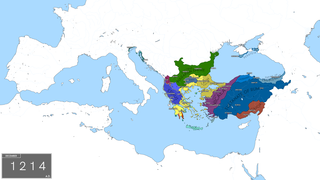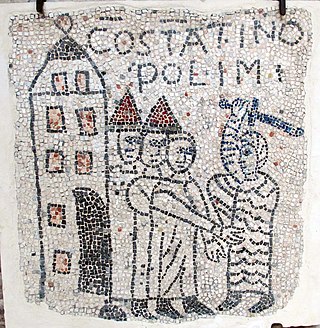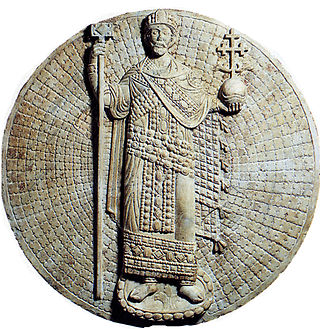Related Research Articles

John IV Doukas Laskaris was emperor of Nicaea from August 16, 1258, to December 25, 1261. This empire was one of the Greek states formed from the remaining fragments of the Byzantine Empire, after the capture of Constantinople by Roman Catholics during the Fourth Crusade in 1204.

Michael V Kalaphates was Byzantine emperor for four months in 1041–1042. He was the nephew and successor of Michael IV and the adoptive son of Michael IV's wife Empress Zoe. He was popularly called "the Caulker" (Kalaphates) in accordance with his father's original occupation.

The themes or thémata were the main military and administrative divisions of the middle Byzantine Empire. They were established in the mid-7th century in the aftermath of the Slavic migrations to Southeastern Europe and Muslim conquests of parts of Byzantine territory, and replaced the earlier provincial system established by Diocletian and Constantine the Great. In their origin, the first themes were created from the areas of encampment of the field armies of the East Roman army, and their names corresponded to the military units that had existed in those areas. The theme system reached its apogee in the 9th and 10th centuries, as older themes were split up and the conquest of territory resulted in the creation of new ones. The original theme system underwent significant changes in the 11th and 12th centuries, but the term remained in use as a provincial and financial circumscription until the very end of the Empire.

The Latin Empire, also referred to as the Latin Empire of Constantinople, was a feudal Crusader state founded by the leaders of the Fourth Crusade on lands captured from the Byzantine Empire. The Latin Empire was intended to replace the Byzantine Empire as the Western-recognized Roman Empire in the east, with a Catholic emperor enthroned in place of the Eastern Orthodox Roman emperors. The main objective of the Latin Empire was planned by Venice, which promoted the creation of this state for their self-benefit.

The Empire of Nicaea or the Nicene Empire was the largest of the three Byzantine Greek rump states founded by the aristocracy of the Byzantine Empire that fled when Constantinople was occupied by Western European and Venetian armed forces during the Fourth Crusade, a military event known as the Sack of Constantinople. Like the other Byzantine rump states that formed due to the 1204 fracturing of the empire, such as the Empire of Trebizond and the Despotate of Epirus, it was a continuation of the eastern half of the Roman Empire that survived well into the medieval period. A fourth state, known in historiography as the Latin Empire, was established by an army of Crusaders and the Republic of Venice after the capture of Constantinople and the surrounding environs.

The megas doux was one of the highest positions in the hierarchy of the later Byzantine Empire, denoting the commander-in-chief of the Byzantine navy. It is sometimes also given in English by the half-Latinizations megaduke or megadux. The Greek word δούξ is the Hellenized form of the Latin term dux, meaning leader or commander.
AlexiosBranas or Vranas was a Byzantine nobleman, attempted usurper, and the last Byzantine military leader of the 12th century to gain a notable success against a foreign enemy.
Anna Komnene Angelina or Comnena Angelina was Empress consort of Nicaea. She was the daughter of emperor Alexios III Angelos and of Euphrosyne Doukaina Kamatera.

The House of Laskaris, Latinized as Lascaris, was a Byzantine Greek noble family which rose to prominance during the late Byzantine period. The members of the family formed the ruling dynasty of the Empire of Nicaea, a Byzantine rump state that existed from the 1204 sack of Constantinople by the Fourth Crusade until the restoration of the Empire under the Palaeologan dynasty in 1261.

The sack of Constantinople occurred in April 1204 and marked the culmination of the Fourth Crusade. Crusader armies captured, looted, and destroyed parts of Constantinople, then the capital of the Byzantine Empire. After the capture of the city, the Latin Empire was established and Baldwin of Flanders was crowned Emperor Baldwin I of Constantinople in the Hagia Sophia.

The mesazon was a high dignitary and official during the last centuries of the Byzantine Empire, who acted as the chief minister and principal aide of the Byzantine emperor. In the West, the dignity was understood as being that of the imperial chancellor.
Arsenios Autoreianos, Ecumenical Patriarch of Constantinople, lived about the middle of the 13th century.

The Thracesian Theme, more properly known as the Theme of the Thracesians, was a Byzantine theme in western Asia Minor. Created either in the mid-7th or the early 8th century as the settlement of the former Army of Thrace, after which it was named, it was one of the larger and more important themes of the Empire throughout its existence based on its proximity to Constantinople. The Thracesian Theme was one of the longest-lived themes, surviving until the region was conquered by the Turks in the early 14th century.

The siege of Constantinople in 1260 was the failed attempt by the Nicene Empire, the major remnant of the fractured Byzantine Empire, to retake Constantinople from the Latin Empire and re-establish the City as the political, cultural and spiritual capital of a revived Byzantine Empire.
Germanus II Nauplius was Patriarch of Constantinople from 1223 until his death in June 1240.

The Battle of Haram or Chramon was fought between the forces of King Stephen II of Hungary and Emperor John II Komnenos of the Byzantine Empire in the year 1128, or possibly earlier – in 1125, in what is now Serbia, and resulted in a major defeat for the Hungarians. The site of the battle was near the confluence of the Karaš/Caraș and the Danube, between Banatska Palanka and Baziaș, on the modern border between Serbia and Romania.
Paul Magdalino is a British Byzantinist who is Bishop Wardlaw Professor (Emeritus) of Byzantine History at the University of St Andrews. He received the 1993 Runciman Award for his monograph on the reign of Manuel I Komnenos (1143–1180), which challenged Niketas Choniates' negative appraisal of the ruler.
A Byzantine–Hungarian War was fought between Byzantine and Hungarian forces on the Danube between 1127 and 1129. Byzantine primary sources, Cinnamus and Choniates, give little detail about this campaign; no dates are specified, and what they do say differs considerably.

Mark Whittow was a British historian, archaeologist, and academic, specialising in the Byzantine Empire. He was a university lecturer at the University of Oxford and a Fellow in Byzantine Studies at Corpus Christi College, Oxford.

The Duchy of Durazzo was a short-lived overseas colony of the Republic of Venice, encompassing the port city of Durazzo and its environs. It was established in 1205, following the dissolution of the Byzantine Empire in the aftermath of the Fourth Crusade, and lasted until it was reclaimed by the Byzantine Despotate of Epirus in 1213.
References
- Angold, Michael (1975), A Byzantine Government in Exile: Government and Society under the Laskarids of Nicaea, 1204–1261, London: Oxford University Press
- Collins, Roger (2019), "Angus MacKay" (PDF), Biographical Memoirs of Fellows of the British Academy, 18: 197–216